Are Incels Less Attractive?
A question that I feel hasn’t satisfactorily been answered yet is if ‘involuntary celibates’ are actually less physically attractive (and if so by how much). It may seem like a given, but if we take a gander at the figures behind the infamous mass killings which have been linked to inceldom, few would describe them as offensive to the eyes. In fact many people express bemusement at how a cute boy like this could end up the way he did:

If you think about it, both incels and who they brand ‘blue pillers’ would predict little difference in attractiveness between incels and the average guy, as while ‘blue pillers’ would say that it has little to do with physical attractiveness, incels would say that the average guy is in their camp.
However, incels would be different in that they’d expect a significant difference between incels and sexually active men, who they believe constitute a physically superior elite.
So should we expect incels to be less attractive?
While looks are an unquestionably important component of mate selection, we can at least imagine a scenario in which everyone was ‘looksmatched’ (as much as they can be at least, the distributions of attractiveness may be different for men and women) and those who were incel just couldn’t find a looksmatched partner for whatever reason.
If this was because unattractive people were less willing to date their other-sex counterparts, we’d probably still see a lower average level of attractiveness among incels but also among ‘femcels’ (even if they weren’t necessarily celibate in the same way).
On the other hand, assuming it were more due to the women’s choice, more attractive otherwise celibate men would have more room to consider dating down in attractiveness, or hooking up with less attractive women, in which case we’d expect celibate men to be less attractive, but perhaps not women.
As far as I know there haven’t been any studies directly sampling self-identified incels and measuring their physical features. I imagine it’d be a challenge to find people willing to sign up. The sample also has a decent chance of ending up being biased. I can see it going a few different ways. Incels who were physically well-off may be more inclined to respond because they’re not as self-conscious. On the other hand there are frequent ‘who has it worse’ competitions. It may also be the case that those who are affiliated with the incel subculture are more extreme outliers than the typical man who is involuntarily celibate in the more general sense, though again it doesn’t seem like it in a physical sense at least judging by the albeit small sample of ‘incel killers’.
A common retort to incels who blame their shortcomings on physical traits is that “I see ugly and short guys with girlfriends all the time when I’m out grocery shopping etc.”. The response is typically along the lines of “but that’s just an anecdote, the exception that proves the rule” or “you just notice them more because of confirmation bias”.
Instead of adding to this pile of anecdotes, here I will go over what empirical data I can find on this question.
While not all men who aren’t sexually active, in a relationship, or haven’t reproduced are necessarily upset about this, let alone identify with the ‘incel’ label, incel will be operationalized as men who haven’t had sex before or in the past year, who are single/unmarried, or haven’t reproduced.
Even if a significant portion of men are sexless, single, or childless by choice, they would at most marginally offset the lower average levels of attractiveness, unless there’s reason to think these men are markedly more attractive than average.
When it comes to relationships it’s a bit more up in the air, as one might argue there’s a larger portion who are single by choice than sexless by choice, and many incels would likely respond to the absence of a gap in attractiveness with the claim that men in relationships are ‘betas’, and ‘chads’ who don’t want to be locked down offset the lower attractiveness among single men (though at the same time the fact that most young men are single (which has been the case for at least 40 years) will often be used to make the case that ‘average isn’t enough anymore’). It’s worth looking into regardless.
Studies
Udry & Eckland (1984): Benefits of Being Attractive: Differential Payoffs for Men and Women
601 males and 751 females who were surveyed in 1955 had their high-school photos rated by six research assistants to see how they predicted outcomes in a follow-up interview conducted in 1970.
They found no relationship between attractiveness and percent never married for men. Interestingly, for women on the other hand the least attractive were about 10x as likely to have never married as the most attractive, and those rated 1 or 2 out of 7 were 42% of the never marrieds despite being 17% of the total sample.
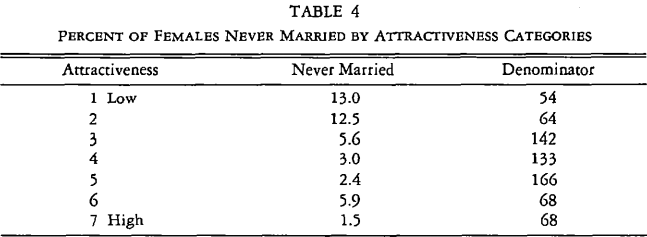
They did however find that for both men and women the least attractive married later on average.
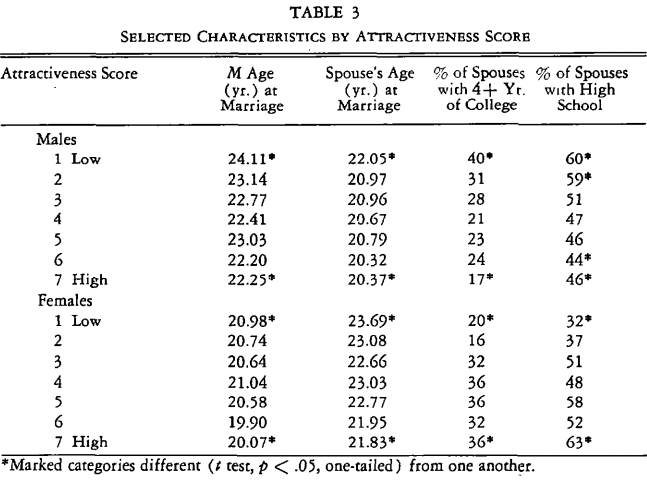
McLaughlin et al. (1997): Family, Peer, and Individual Correlates of Sexual Experience Among Caucasian and Asian American Late Adolescents
148 Caucasian and 202 Asian American undergrads between the ages of 18-22 participated in this study.
There were no significant differences between Caucasian men who reported no or one to two partners, but those reporting three or more rated themselves higher. Caucasian women with sexual experience rated themselves higher. There were no significant differences among Asians.
It’s worth noting however that self-rated attractiveness is known to be not too reliable as a measure as it’s largely a reflection of the person’s self-esteem.

Weeden et al. (2007): Subjective and Objective Measures of Attractiveness and Their Relation to Sexual Behavior and Sexual Attitudes in University Students
456 undergrads (47.8% male; M age = 19.2) participated in this study. They had ten opposite-sex raters rate three face photographs, one from the front smiling, one from the front with a neutral expression, and one in profile with a neutral expression, which were then averaged into a single measure.
This measured attractiveness didn’t significantly correlate with relationship status. Self-rated attractiveness did very weakly at .15. They tested for sex differences in the variables listed in the table below, but few were notable. Physical attractiveness also failed to significantly correlate with having had sex before 18.
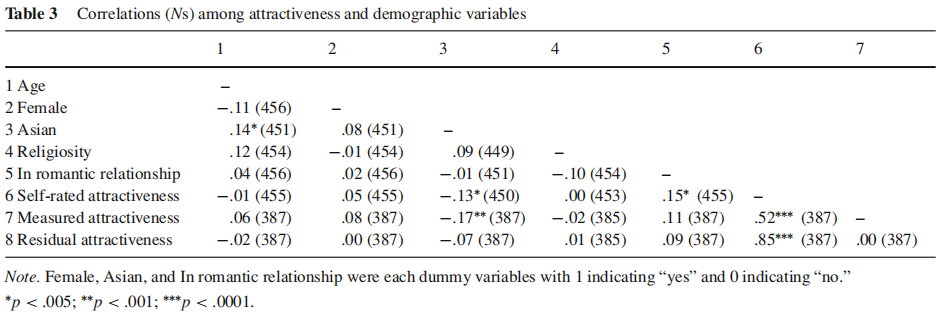
Jokela et al. (2009): Physical attractiveness and reproductive success in humans: Evidence from the late 20th century United States
The following data is from interviews of Wisconsin Longitudinal Study participants conducted in 1992 of men born between 1937-1940. In 2004 a random subsample had their yearbook photos rated by 6 men and 6 women each.
It looks like there was a difference between the lower quartile of attractiveness and the other quartiles when it comes to probability of reproducing by up to about 5-8%. It looks like the differences are significant at some points along the age continuum, at least between them and attractive men. This would mean that 1-2% of the male population were genetic dead ends on this basis (assuming of course this is due to selection against ugliness and not some mediating factor).

Jaeger et al. (2011): “A Thing of Beauty is a Joy Forever”? Returns to Physical Attractiveness over the Life Course
This study also employed data from the Wisconsin Longitudinal Study. It found no significant associations between the facial attractiveness or height and the marital status of men at 25, 35, 54, and 65, except for a marginally significant association between facial attractiveness and marital status at age 25. A significant difference was found between facial attractiveness and a marginally significant negative association between height and marital status for women at age 25.
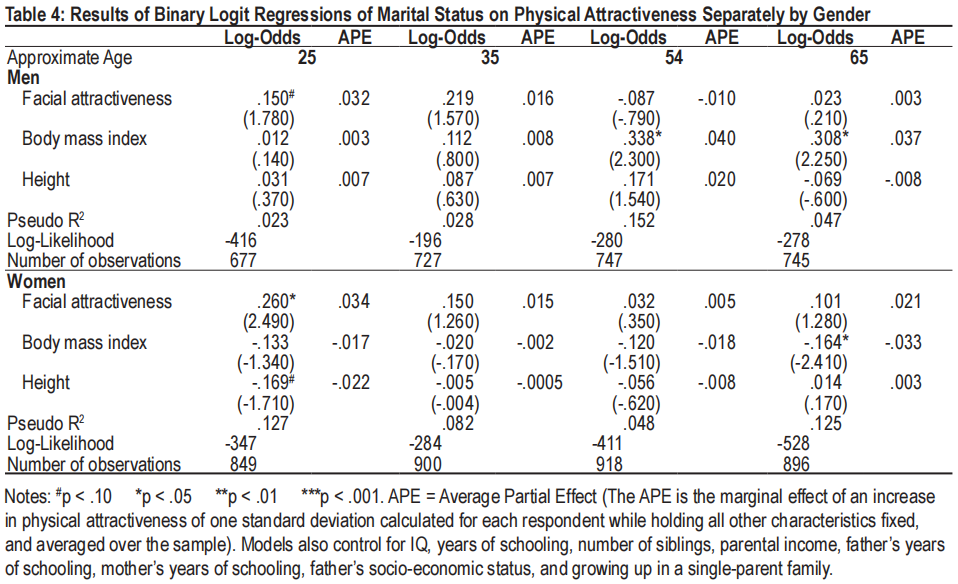
Prokop & Fedor (2011): Physical attractiveness influences reproductive success of modern men
480 students were asked to provide photographs of men currently over 40 when they were 20, as well as information regarding their number of children, marital status, height, etc. Their facial attractiveness was rated on a 1-7 scale by 27 female students.
We see significant differences in the facial attractiveness, height, and educational level of single and married men. The difference in facial attractiveness would translate to a Cohen’s d value of .3, and in height one of .23. These would generally be considered small effect sizes.

When it came to the probability of parenthood, facial attractiveness and educational level had a significant effect, but not height.
Poulsen et al. (2013): Physical attraction, attachment styles, and dating development
242 single Latter-day Saints (43% male, M age = 22; 57% female, M age = 20) had their facebook pictures rated by six research assistants.
The table below displays the association between physical attractiveness and dating variables over a 32 week period.
For men, physical attractiveness correlated at -.24 with dateless weeks and .23 with having had a relationship during this time, but there wasn’t a significant association between physical attractiveness and number of first dates or having 2 or more dates with the same person.
For women, it correlated at -.37 with dateless weeks, .22 with first dates, .36 with 2 or more dates with the same person, and .29 with having had a relationship.
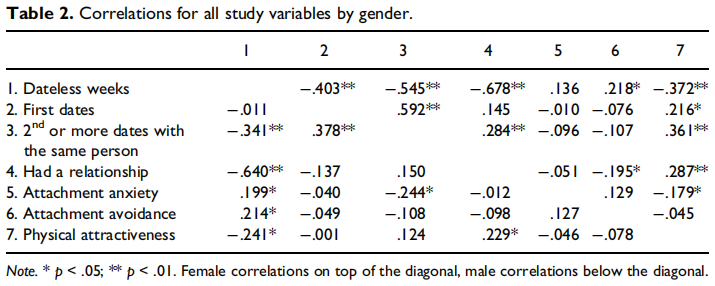
Prokop & Fedor (2013): Associations between body morphology, mating success and mate preferences among Slovak males and females
150 male and 373 female single and childless undergrads participated in this study.
For men, self-rated attractiveness was significantly lower among virgins (Wald’s χ2 = 7.51, df = 1, p = 0.006).
For women, BMI was significantly higher among virgins (Wald’s χ2 = 10.91, df = 1, p = 0.0009).
Lukaszewski et al. (2014): Condition-dependent calibration of men’s uncommitted mating orientation: Evidence from multiple samples
A .35 correlation between overall physical attractiveness and being sexually experienced was found in 168 male undergrads, and one of .32 in 102 female undergrads.
Allen et al. (2020): Adolescent Peer Relationship Qualities as Predictors of Long-term Romantic Life Satisfaction
165 adolescents (43% male) were followed from ages 13 to 30. Attractiveness was rated by eight research assistants who viewed video recordings of the subjects when they were age 13 and 17.
Physical attractiveness ratings from either age didn’t predict romantic life satisfaction at age 27-30, romantic relationship satisfaction at age 17-19, or having had sexual intercourse at age 17. Physical attractiveness at 13 had a small effect on number of boy or girlfriends at age 17, but physical attractiveness at 17 didn’t. The only highly significant effect was on physical romantic involvement, which was operationalized as the number of romantic partners with which participants reported having made out. Gender didn’t moderate these effects.
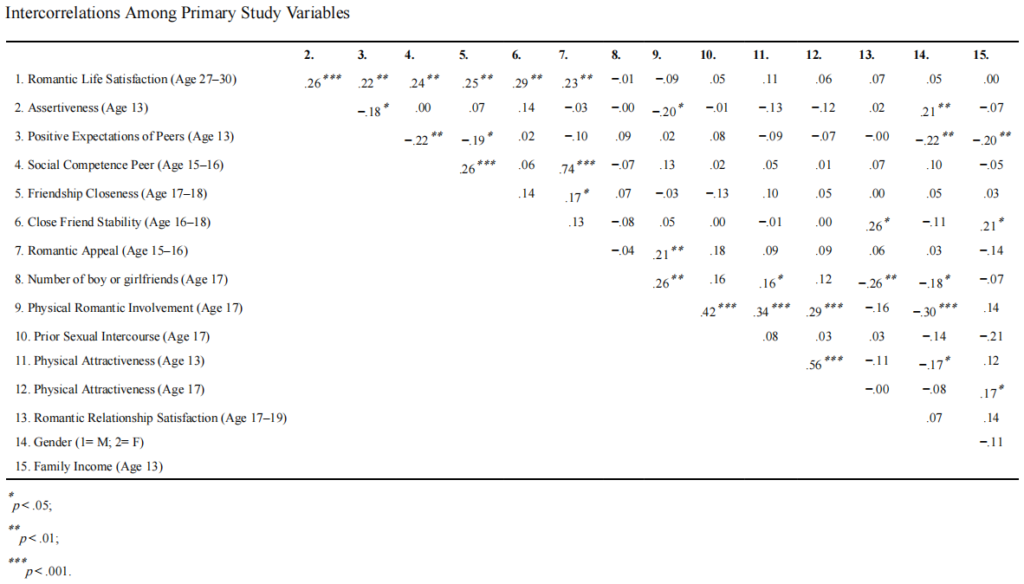
Spielmann et al. (2020): The predictive effects of fear of being single on physical attractiveness and less selective partner selection strategies
122 participants (38.5% male; M age = 21.6) participated in study 1. Ten research assistants rated their photos.
FOBS refers to fear of being single, or the concern, anxiety, or distress regarding the current or prospective experience of being without a romantic partner. Presumably people who are defined by their lack of success with women would typically fall into this category.
There was no association between judge-rated attractiveness and FOBS, and no gender interaction. The association between subjectively rated attractiveness and FOBS lost its significance (at the .1 level) after being entered into a regression model controlling for covariates.
We do however find a small correlation of .21 between judge-rated attractiveness and relationship status, and once again a somewhat stronger one between self-rated attractiveness and relationship status.
171 participants (52% male; M age = 22.6) participated in a speed-dating study. 28 research assistants rated their photos. FOBS once again failed to significantly predicted judge-rated attractiveness, and the relationship between self-rated attractiveness and FOBS lost its significance (again at the .1 level) after entering a hierarchical regression.
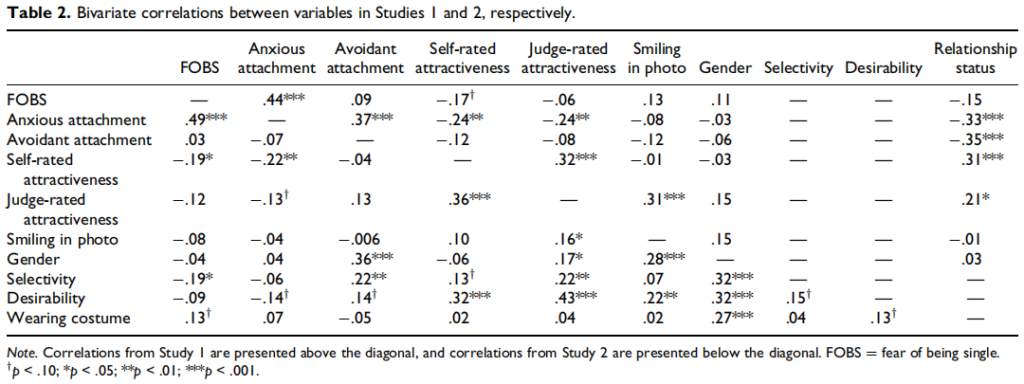
Arnocky et al. (2023): Self-perceived Mate Value is Predicted by Biological and self-reported Indices of Health in Young Adults
691 participants (39.1% male; M age = 20.7) had their saliva collected and reported the severity and frequency with which they suffered from various poor health symptoms. They also filled out a questionnaire assessing their self-perceived mate value.
While as expected self-perceived mate value correlated positively with Salivary Immunoglobulin A (a marker of immunocompetence) and negatively with poor health, none of these variables were significantly associated with relationship status. This didn’t change when analyzing the sexes separately.
Although we’re more interested in dichotomous rather than continuous variables here as having less partners doesn’t mean having none, only self-perceived mate value correlated very weakly at .14 with lifetime sex partners for men or women.
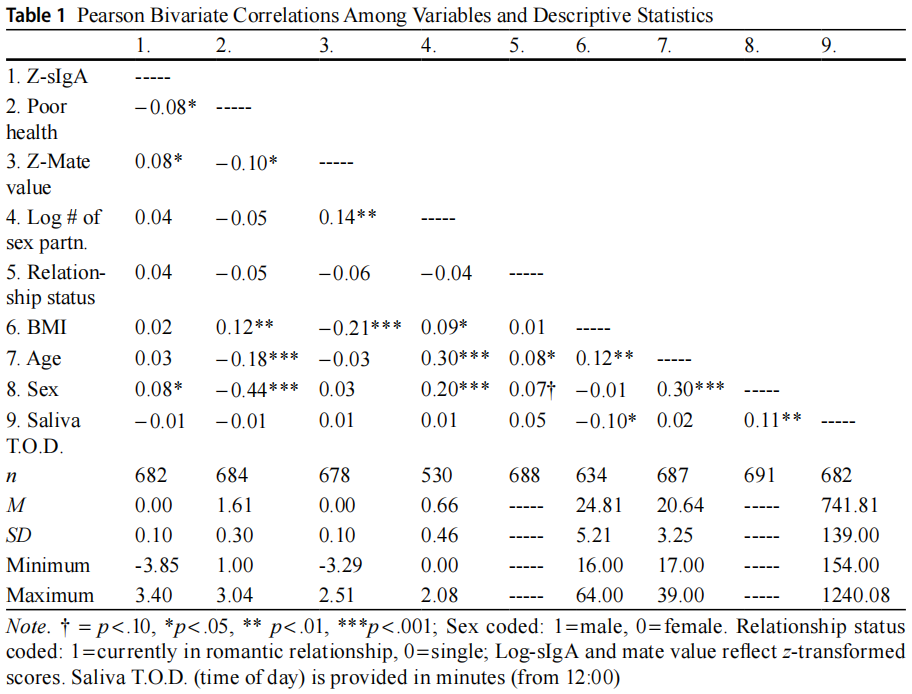
Other Data
This data is from Wave III (2001-02) of The National Longitudinal Study of Adolescent to Adult Health, in which the participants would’ve been between the ages of 18-26. I limited the sample to those who were at least mostly heterosexual. Physical attractiveness was rated by the interviewers on a 1-5 scale.
We do find a highly statistically significant difference in the attractiveness ratings of men who were and weren’t virgins, but the difference itself wasn’t massive. Interestingly, there was also a significant difference for women in the same direction.
There were no significant differences in height, though the difference for men of about .4 inches approached significance.

The same pattern can be seen for sex in the past year. People of both genders who had had sex in the past year were rated as more physically attractive, but didn’t significantly differ in height.

These are the ratings for those who had or hadn’t either been married or lived with someone in a ‘marriage-like relationship’ for at least one month. The only significant difference was that women who had had such a relationship were apparently less attractive.

Now let’s move onto the General Social Survey, a nationally representative biennial US survey. The 2016 and 2018 surveys included a measure of the participants’ physical attractiveness, rated by the interviewer. The 2014, 2018, and 2022 surveys asked the participants for their height.
Among straight men and women between the ages of 18-30, we find no significant differences in the mean looks rating or height among those who had or hadn’t had sex with an opposite-sex partner since turning 18.

The only significant difference between those who had or hadn’t had sex in the past year was among women, with women who had apparently being more attractive.

There were no differences between those who were or weren’t in a relationship, with the exception of a marginally significant difference in men’s height, with men in a relationship being taller on average.

I downloaded the raw data from Kordsmeyer et al. (2018), which recruited 164 heterosexual 18-34 men with a mean age of 24.2. Facial and bodily attractiveness were rated on an 11-point likert scale. There were other measures but these (and height) seemed the most relevant.
Of the variables relating to relationship status, sex in the past year, and one-night stand experience, across the 3 physical measures of facial attractiveness, bodily attractiveness, and height, the only significance was in the facial attractiveness of those who had or hadn’t had sex in the past year.

In a follow-up 18 months later, facial attractiveness no longer significantly predicted having had sex in the past year. However, there were now significant differences in the bodily attractiveness of men who were single or in a relationship and men who had or hadn’t had sex in the past year.

Conclusion
While we found associations in the expected direction, the magnitude of the effects are perhaps more subtle than some would’ve anticipated and may require substantial sample sizes to consistently detect.
In the Add Health dataset, since the interviewers were apparently feeling generous, those rated a 1 (‘very unattractive’) represented less than 2% of the sample. Despite this we see that even the vast majority of them or those rated 2 (‘unattractive’) were not virgins.
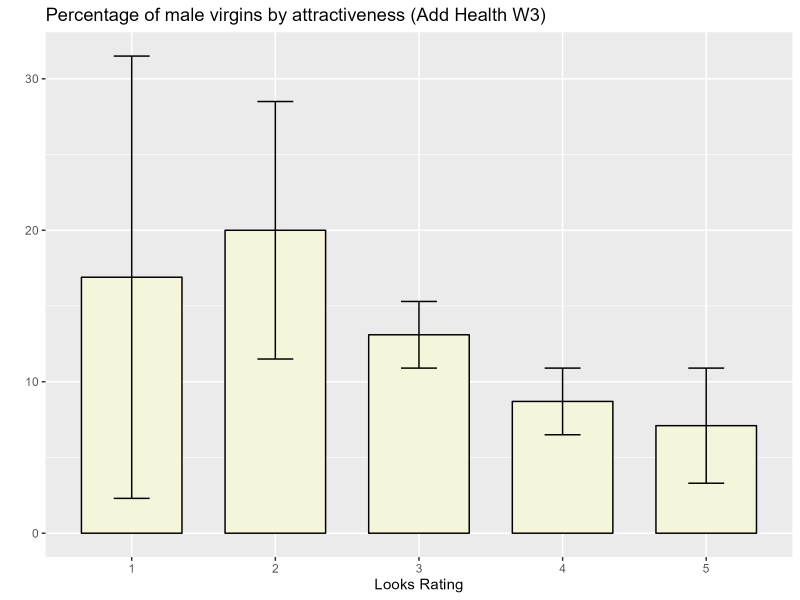
These are correlations between looks/height and virginity or being sexless in the past year. If we take a correlation coefficient of .08 and square it, we get the coefficient of determination, which shows how much variance is shared by the variables. This means that less than 1% of the variance in virginity would be explained by the predictor variable.
It also seems like if we look at more recent data and sexual experience, sexlessness in the past year in the 2016-18 GSS and the 2018 study, looks and height are not especially important like the dating app meme would suggest.
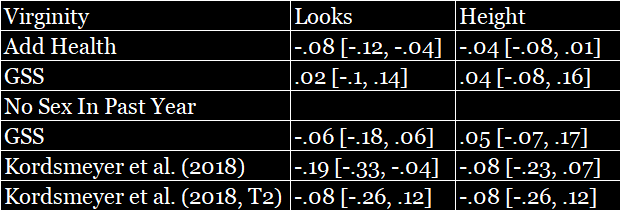
It seems then that while being physically subpar is no doubt a handicap to some degree, when it comes down to determining who has a place in the mating pool, it’s only a small piece of the puzzle. There are a plethora of other traits and circumstances that can cause one to lack sexual or romantic experience. I’ve gone over one of the big ones: autism, and others will likely be explored at a later date.
It’s probably correct to say that physical attractiveness is more pertinent to one’s ‘league’, as it has a stronger association with the attractiveness of peoples’ partners (Feingold, 1988) than whether they have one, have had one, or how many they’ve had.
We also found evidence for an effect among women. It could be the case that femcels are a thing, even if less in the sexual sense (though even men may have their limits there too), or it may be that they are unwilling to date within their appropriate pool. It may also be mediated by a psychological mechanism like introversion which could both make someone pay less attention to their appearance and be in less social situations to meet people (similar processes could apply to men too). I leave this open to interpretation.
What is clear is that we must retire the reductive notion that incel = ugly (and on the incel side that noncel = attractive). Sure, if you randomly sample a bunch of inels and noncels the incels may be slightly less attractive on average, but there will be far more overlap than separation, and there will be many above average looking incels just as there will be many below average looking noncels. It’s not something you can tell by looking at someone or measuring their jawbones.
References
Udry, J. R., & Eckland, B. K. (1984). Benefits of being attractive: differential payoffs for men and women. Psychological Reports, 54(1), 47–56. https://doi.org/10.2466/pr0.1984.54.1.47
McLaughlin, C. S., Chen, C., Greenberger, E., & Biermeier, C. (1997). Family, peer, and individual correlates of sexual experience among Caucasian and Asian American late adolescents. Journal of Research on Adolescence, 7(1), 33–53. https://doi.org/10.1207/s15327795jra0701_3
Weeden, J., & Sabini, J. (2007). Subjective and objective measures of attractiveness and their relation to sexual behavior and sexual attitudes in university students. Archives of sexual behavior, 36(1), 79–88. https://doi.org/10.1007/s10508-006-9075-x
Jokela M. (2009). Physical attractiveness and reproductive success in humans: Evidence from the late 20 century United States. Evolution and human behavior : official journal of the Human Behavior and Evolution Society, 30(5), 342–350. https://doi.org/10.1016/j.evolhumbehav.2009.03.006
Jæger, M. M. (2011). “A Thing of Beauty is a Joy Forever”? Returns to Physical Attractiveness over the Life Course. Social Forces, 89(3), 983–1003. https://doi.org/10.1093/sf/89.3.983
Prokop, P., & Fedor, P. (2011). Physical attractiveness influences reproductive success of modern men. Journal of Ethology, 29(3), 453–458. https://doi.org/10.1007/s10164-011-0274-0
Poulsen, F. O., Holman, T. B., Busby, D. M., & Carroll, J. S. (2013). Physical attraction, attachment styles, and dating development. Journal of Social and Personal Relationships, 30(3), 301–319. https://doi.org/10.1177/0265407512456673
Prokop P, Fedor P. Associations between body morphology, mating success and mate preferences among Slovak males and females. Anthropol Anz. 2013;70(2):121-35. doi: 10.1127/0003-5548/2013/0284. PMID: 23980387.
Lukaszewski, A. W., Larson, C. M., Gildersleeve, K. A., Roney, J. R., & Haselton, M. G. (2014). Condition-dependent calibration of men’s uncommitted mating orientation: Evidence from multiple samples. Evolution and Human Behavior, 35(4), 319–326. https://doi.org/10.1016/j.evolhumbehav.2014.03.002
Allen, J. P., Narr, R. K., Kansky, J., & Szwedo, D. E. (2020). Adolescent Peer Relationship Qualities as Predictors of Long-Term Romantic Life Satisfaction. Child development, 91(1), 327–340. https://doi.org/10.1111/cdev.13193
Spielmann, S. S., Maxwell, J. A., MacDonald, G., Peragine, D. E., & Impett, E. A. (2019). The predictive effects of fear of being single on physical attractiveness and less selective partner selection strategies. Journal of Social and Personal Relationships, 37(1), 100–123. https://doi.org/10.1177/0265407519856701
Arnocky, S., Denomme, B., Hodges‐Simeon, C. R., Hlay, J. K., Davis, A. C., & Brennan, H. (2023). Self-perceived Mate Value is Predicted by Biological and self-reported Indices of Health in Young Adults. Adaptive Human Behavior and Physiology, 9(1), 54–71. https://doi.org/10.1007/s40750-022-00209-4
Kordsmeyer, T. L., Hunt, J., Puts, D. A., Ostner, J., & Penke, L. (2018). The relative importance of intra- and intersexual selection on human male sexually dimorphic traits. Evolution and Human Behavior, 39(4), 424–436. https://doi.org/10.1016/j.evolhumbehav.2018.03.008
Feingold, A. (1988). Matching for attractiveness in romantic partners and same-sex friends: A meta-analysis and theoretical critique. Psychological Bulletin, 104(2), 226–235. https://doi.org/10.1037/0033-2909.104.2.226

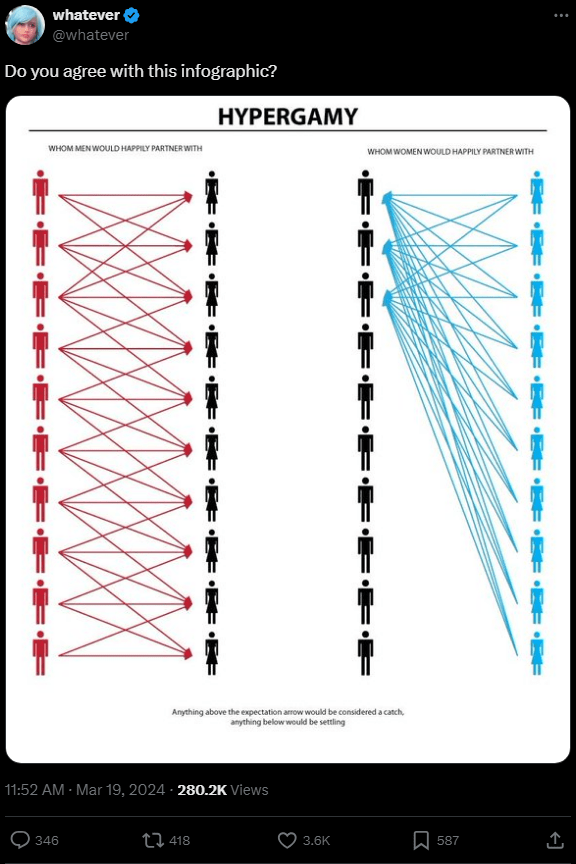
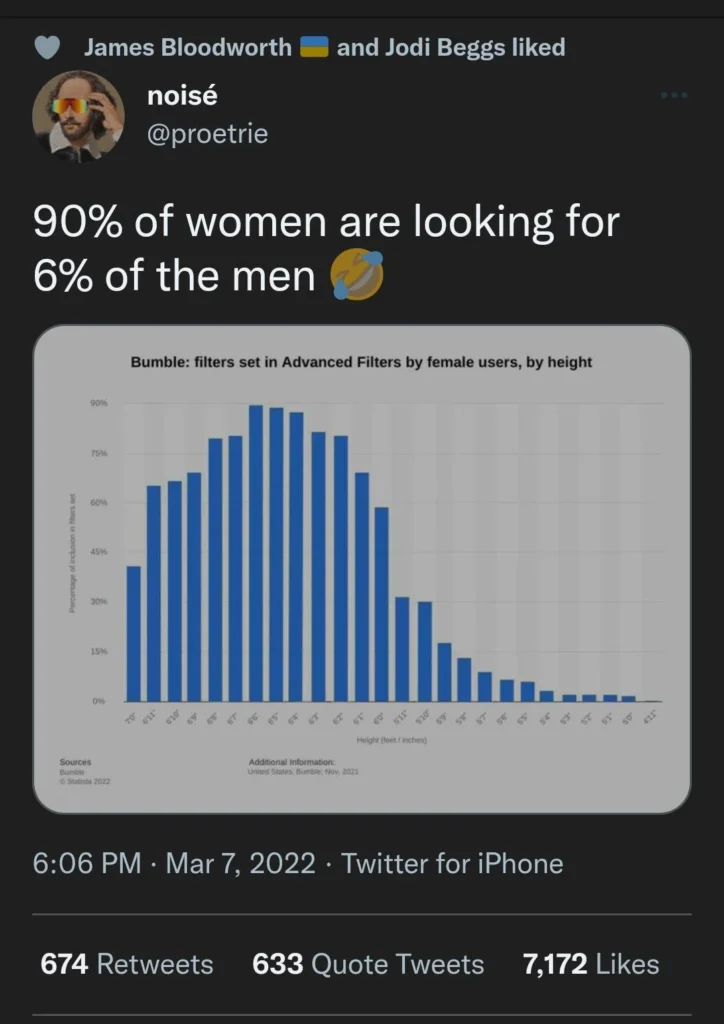
Do some real research you pathetic white knight cuck.
This is the same kind of brain damaged analysis in sex differences research. “Sure, if you randomly sample a bunch of women and find that their IQ is much lower on average, that doesn’t actually mean much because if you get lucky and test the right woman, you can produce a meaningless anecdote!”
No, women are stupid. Incels are ugly. And you are a pseud.
Its like you read my mind You appear to know a lot about this like you wrote the book in it or something I think that you could do with some pics to drive the message home a little bit but instead of that this is fantastic blog An excellent read I will certainly be back
Hi i think that i saw you visited my web site thus i came to Return the favore I am attempting to find things to improve my web siteI suppose its ok to use some of your ideas
I came across this wonderful website recently, they deliver excellent content for viewers. The site owner knows how to provide value to the audience. I’m pleased and hope they continue their splendid service.
we came cross the most nuanced and rational blackpillers. thanks for user”cuckpill”and “fuckyou”.
This page is phenomenal. The splendid substance exhibits the essayist’s commitment. I’m overwhelmed and expect more such unfathomable posts.
Hi my loved one I wish to say that this post is amazing nice written and include approximately all vital infos Id like to peer more posts like this
Wonderful web site Lots of useful info here Im sending it to a few friends ans additionally sharing in delicious And obviously thanks to your effort
Somebody essentially help to make significantly articles Id state This is the first time I frequented your web page and up to now I surprised with the research you made to make this actual post incredible Fantastic job